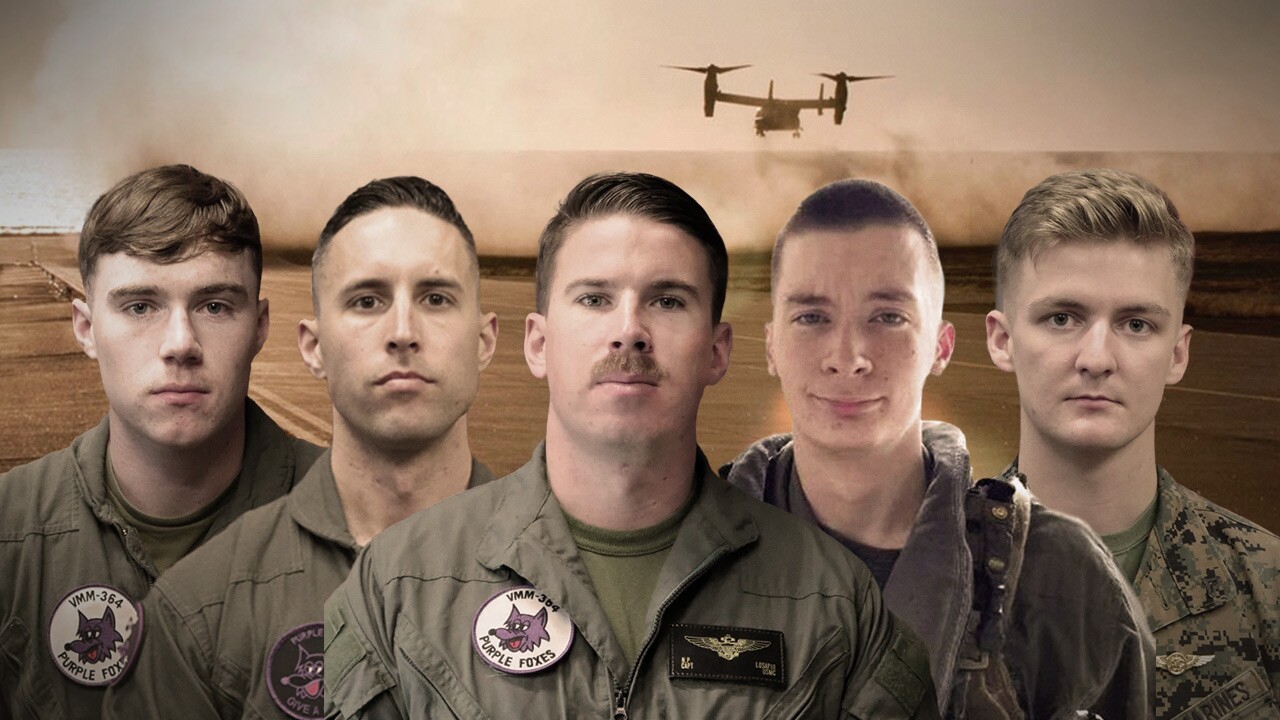OCEANSIDE, Calif. — Kelsie Hancock tears up when she’s asked about her late fiancé’s experience flying the Osprey.
“He has been coined as a once-in-a-generation pilot, which gets me so emotional,” Hancock says, wearing a necklace with the letter N.
Capt. Nick Losapio took pride in flying the Bell Boeing aircraft that’s unlike any other in the world and is credited by the Pentagon with changing how wars are fought.
The V-22 Osprey takes off like a helicopter and uses jet engines to fly fast like a plane.
“He was well respected. He had three combat deployments in Kuwait and Saudi Arabia,” Hancock, a reservist with the Marines, says.

It was closer to home in June 2022 where Losapio, 31, along with Capt. John Sax, Cpl. Seth Rasmussen, Cpl. Nathan Carlson and Lance Cpl. Evan Strickland took their last flight.
The crew was doing a training exercise above the desert near El Centro, California, about two hours east of San Diego, when they crashed.
Investigators later blamed the accident on mechanical failure and said a dual hard clutch engagement caused the crash.
Before the Osprey went down, Losapio made a radio call to report he had a hot gearbox – a sign the aircraft’s oil was too warm.
Hancock told Team 10 investigative reporter Austin Grabish it wasn’t her fiancé’s first time having the problem.
"There were sometimes he had to do emergency landings. There was one time in particular when he was deployed, he had to do an emergency landing in Syria because of an engine failure," she says.
After the crash, the Marine Corps barred an undisclosed number of Ospreys from flying until a part called the input quill was replaced. It's in the gearbox that houses the clutch, allowing the aircraft to fly like a helicopter/airplane hybrid.
Boeing pays $8.1 million to settle allegations
Osprey parts have recently come under the microscope of federal investigators.
The Department of Justice announced last September that Boeing would pay $8.1 million to settle allegations it violated the False Claims Act.
The DOJ alleged Boeing failed to follow critical manufacturing specifications when making parts for the V-22 after three whistle-blowers inside a Boeing plant in Pennsylvania came forward.

A Boeing spokesperson told Team 10 the company entered a settlement to resolve the allegations without admission of liability.
Since the 2022 mishap near El Centro, two more Ospreys have crashed, killing 11. The accidents triggered the U.S. military to ground its entire fleet of nearly 500 last December.
“I had heard people say things like the Osprey is a widow maker... But I trusted in his ability. I knew he was very diligent and smart, and he studied constantly,” Hancock says.
61 killed in mishaps since 1992
A Team 10 analysis relying on old news stories and crash reports found that 61 Americans have died in Osprey mishaps since 1992. Dozens more have been injured on the aircraft.
A new congressional oversight committee is investigating the Osprey and working to get to the bottom of what it calls “long-term problems” with the aircraft.
“There are issues that are basically due to the design and cannot be mitigated very easily,” expert pilot Rex Rivolo told Team 10 in an interview from New York.
Rivolo analyzed the Osprey for the Pentagon and wrote a memo in 2003 raising concerns, highlighting what he called six critical issues with the V-22.
"The aircraft is basically a poor helicopter and a poor airplane. That is the compromise that you make in order to have this capability," he explained.
Rivolo warned the aircraft was more likely to crash in hostile situations than a regular helicopter.
He also found the Osprey was prone to roll and warned its lack of auto-rotation capability didn't meet the threshold for a survivable emergency landing.
“If you lose both engines in a helicopter mode, and you're below 5,000 to 6,000 feet, you're going to die. There's no solution there,” he says.
Team 10 asked the Pentagon to respond to Rivolo’s claims. Follow this link to read the entire response we got.
A defense official told us the V-22’s drive system lets it keep flying if an engine fails and says safety improvements are being made.
They include giving pilots new cues during landings with poor visibility and a time limit on input quill parts.
The military is now working with the theory that aging clutches are to blame for the hard clutch engagement problem.

But the Pentagon admits the theory hasn't been definitively proven and that isn’t sitting well with Hancock.
“I personally struggle to believe the gearbox had nothing to do with [the crash],” she says. “Most of the time when the plane wasn’t working, and he had to cancel flights was because of gearbox issues.”
The Pentagon would not say when the Osprey could be back in the air.





